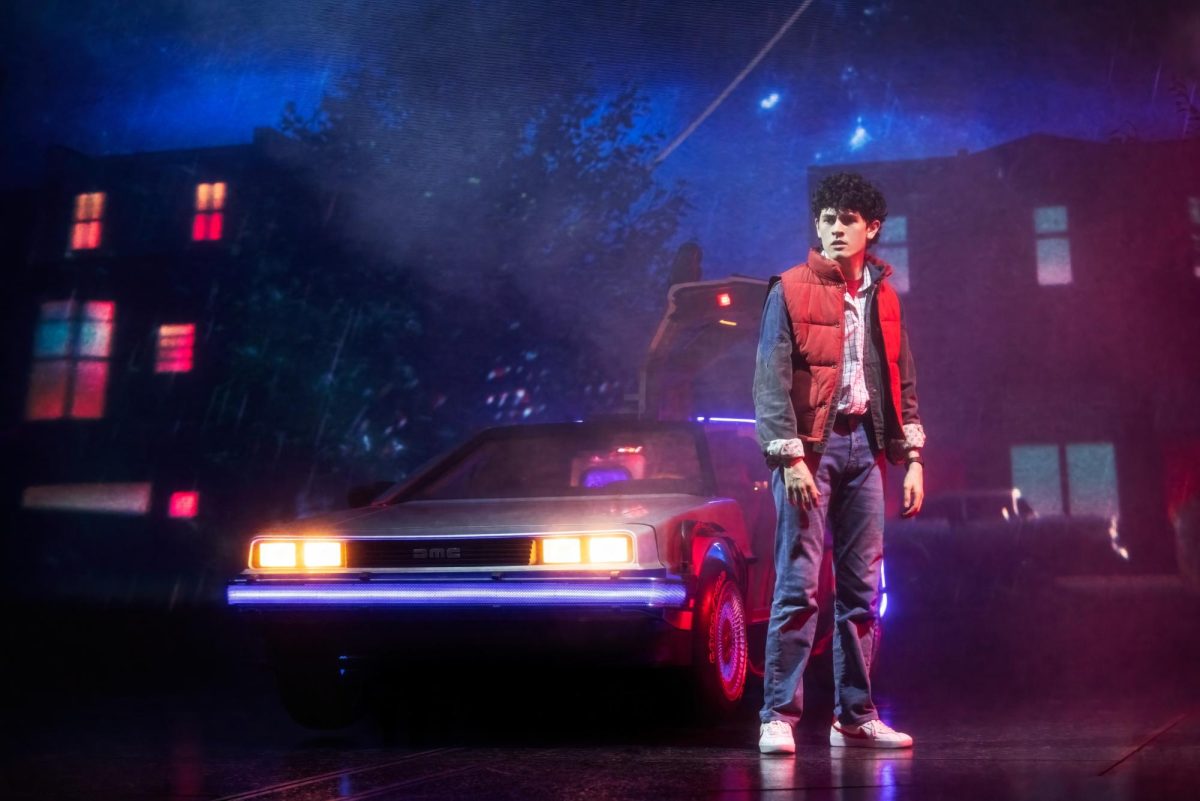“Back to the Future: The Musical” is a 155 minute spectacle that will keep your eyes on the stage whether you want it to or not. While the DeLorean time machine spins over the heads of audiences at the Winter Garden Theatre in Midtown Manhattan, audience members may ask themselves: “How did we get here?”
The musical adaption of the sci-fi/comedy franchise comes with 17 (almost original) songs and is nearly a half hour longer than the original 1985 Back to the Future’s running time. While preparing for the performance and witnessing the replica of the DeLorean, it is only then that you remember …
As the lights dim, and the rather gorgeous pre-show look fades away, one’s ears are blasted with the Back to the Future theme, accompanied by some large-scale video work courtesy of Finn Ross.
After an almost word-for-word rendition of the film’s opening, audience members are welcomed to the world of musicals when Alan Silvestri and Glen Ballard’s songs begin and the ensemble enters. It is at this moment that you second-guess what you’ve gotten yourself into but, three numbers later, Hugh Coles’ deeply committed George McFly enters and something grabs your attention again. For the majority of the show, viewers will continue on this rollercoaster of emotions.
After fidgeting about through the fourth musical number in the first 15 minutes of the show, the DeLorean not only makes its grand entrance (another wake-up-slap), but the iconic Doctor Emmet Brown (Roger Bart) enters as well.
At first, though, it’s difficult to not compare Bart to Christopher Lloyd’s beloved performance, the former’s charisma and originality makes a wholly new interpretation of the role, something commendable when dealing with filling such big shoes. And — as Casey Likes’ somewhat less original Marty McFly hops into that design conglomerate — the audience is brought back to 1955. This all happens in a thrilling sequence, featuring design integration by the sound and lighting team (Gareth Owen, Tim Lutkin and Hugh Vanstone). At this point, there is no turning back.
While audience members are greeted with one swanky 11 o’clock style number after another — one of which features an excellent Jelani Remy) — it’s difficult to not feel a little bit conflicted. Should we be indulging this type of big, brash night of theater? Should we let ourselves smile at such impressive staging but mediocre lyrics? The truth is, we always have been.
“Back to the Future” has no shortage of an audience demographic, but how a $23.5 million musical will find continued success is only something time will tell.
We overlook narrative issues in “Wicked” to sing along to Stephen Schwartz’s score; “The Phantom of the Opera” has its cliche melodrama, but Hal Prince’s staging makes it worth it; and “Cats” … well, I don’t know about that one. Point is, all of these shows have had wildly successful productions despite their inherent, often glaring flaws.
“Back to the Future: The Musical” may have just as many issues as the other titles mentioned, but it’s still staged by some of the best minds of modern theater. With “The Phantom of the Opera’s” closure in April, perhaps we’re due for a “Big Broadway” production like this one. Such a recognizable series, “Back to the Future” has no shortage of an audience demographic, but how a $23.5 million musical will find continued success is only something time will tell.
The rest of the production drags out, with almost 40 minutes worth of songs in Act 2, but the show wakes the audience up again as it nears the iconic climax of the story. The protagonist travels back to the future in a perfect 10-minute amalgamation of video, lighting, sound and possibly every other department backstage; this is perhaps the reason anyone would at least consider buying a ticket.
Though the light intensity may blind you, and the speakers may do some damage, viewers (briefly) get the chance to time travel as well. Invoking memories of the iconic “Phantom” chandelier, the spectacle feels different, but it also feels refreshing.
Then, as expected, viewers get another 10 minutes of unnecessary song and dance, until the DeLorean eventually soars overhead for the grand finale. Though Bob Gale’s new material for the book attempts to shine glimmers of depth, it’s an iconic piece that can speak for itself. We may not need a ballad for Doctor Brown, but we’ll certainly take “Johnny B. Goode.”
This production may signal a turning point for this industry, but maybe, in this post-pandemic climate, we need something similar to this musical playing eight nights a week. Will it stand the test of time? Will it be Broadway’s next long-running spectacle staple? You may have to cheer for the DeLorean and experience it yourself to find out.
“Back To The Future: The Musical” continues on its open-ended run on Broadway at The Winter Garden.

